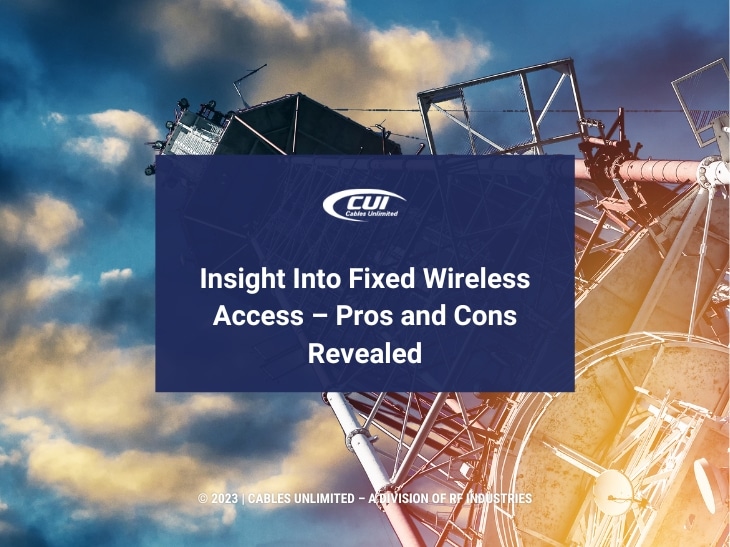At the end of 2022, there were 100 million fixed wireless access (FWA) connections worldwide. That represented 17% of all fixed broadband connections. FWA is expected to grow to 300 million by the end of 2028, nearly 80 percent using 5G.
Using 5G, FWA delivers optical fiber speed without an extensive cable network. As such, it’s a key component in bridging the digital divide between rural and dense urban communities. This article defines fixed wireless, examines what makes up a fixed wireless system, compares it to satellite and fiber access, and explores the pros and cons.
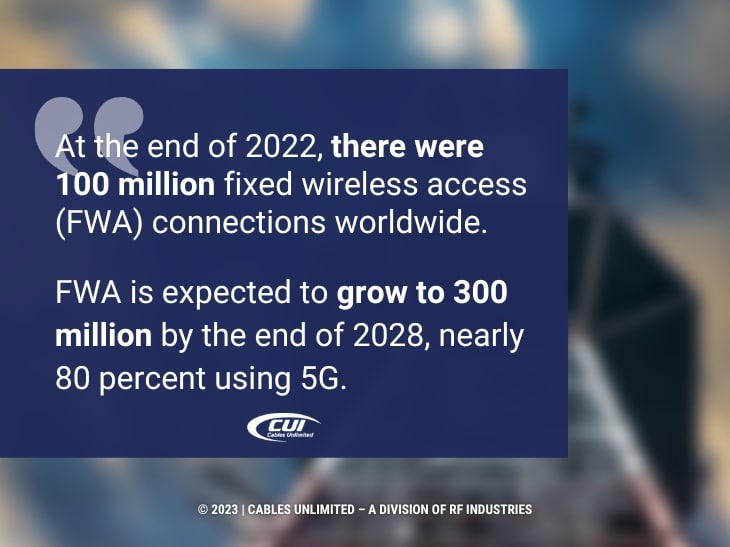
What Is Fixed Wireless?
Fixed wireless networking is a “last mile” technology that bridges the gap between a high-speed fiber optic Internet backbone and the final step to homes and offices. It uses wireless devices powered by utility mains in homes and offices and an antenna to deliver broadband internet. This differs from mobile wireless connections that use batteries for electrical power and the cell phone’s internal antenna.
The fixed wireless connection uses 4G, 5G, and soon 6G from nearby cell towers. It can also use supercell towers for wider coverage. This bypasses the “last mile” telephone system cables, whether slow-speed twisted pair or high-speed fiber optic cables.
It is ideal for providing broadband access to remote areas. The radio frequency link for the “last mile” avoids digging to install fiber optic cable that might need to run miles between homes and offices in a rural location. The use of cell towers also means that fixed wireless access can be readily expanded to new subscribers within the range of the network of cell towers.
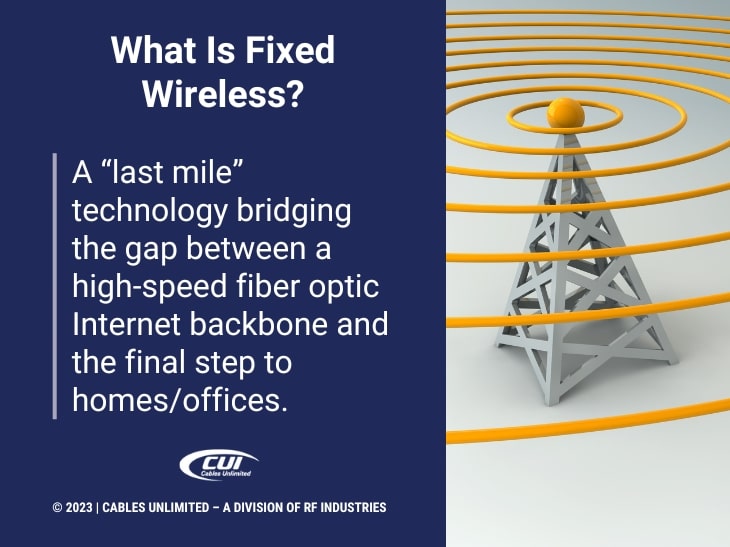
What Makes Up a Fixed Wireless System?
The fixed wireless system begins with the cell tower. That signal is received via an antenna in a home or business. The signal is then processed by a modem with a router moving the signal either by Ethernet cable or Wi-Fi to the various devices through the home or office.
The antenna is a small dish capable of receiving 4G, 5G, or in some cases, millimeter wave signals. It must be mounted in the clear with a direct line of sight to the tower. Any obstructions will reduce the signal level or entirely prevent communication. It also needs to be secure to avoid shifting in high winds.
How Does Fixed Wireless Compare to Fiber and Satellite Access?
As noted above, fixed wireless uses an antenna to receive the Internet signal. With cable Internet access, the fiber optic cable or copper twisted pair is routed directly to the home or office. For satellite connections, an antenna is also required.
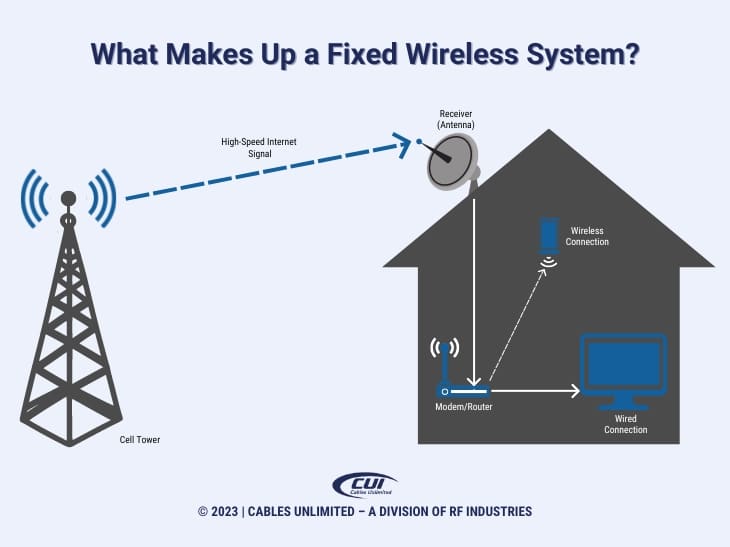
In terms of network speed, fixed wireless offers moderate speed and latency. Fiber offers very high speed and low latency. In comparison, satellite provides low speed and high latency.
While satellite access covers the world, it does require specialized receiving equipment. And because of the long distances involved in transmitting and receiving signals first to the satellite and then back to Earth, the transmission speeds are lower, and the latency is higher than fixed wireless or direct fiber.
What Are the Pros and Cons of Fixed Wireless Systems?
From the above, you should be getting a good idea of the relative pros and cons of a fixed wireless system compared to fiber and satellite systems. Here’s a quick list to bring it all together.
Pros of Fixed Wireless Access
- Quick and affordable to install in a home or business.
- Extends coverage to rural areas without digging and installing cables.
- Bridges fiber to the home or office connectivity gaps.
- No phone or Internet line is required.
- Lower latency over satellite wireless access.
Cons of Fixed Wireless Access
- Line of sight requirement to the cell tower.
- Potential weather interference with the RF signal.
- Higher average cost for installation.
- Limited radio frequency spectrum for fixed wireless channels.
- Wireless security and interference issues versus fiber optic cables.
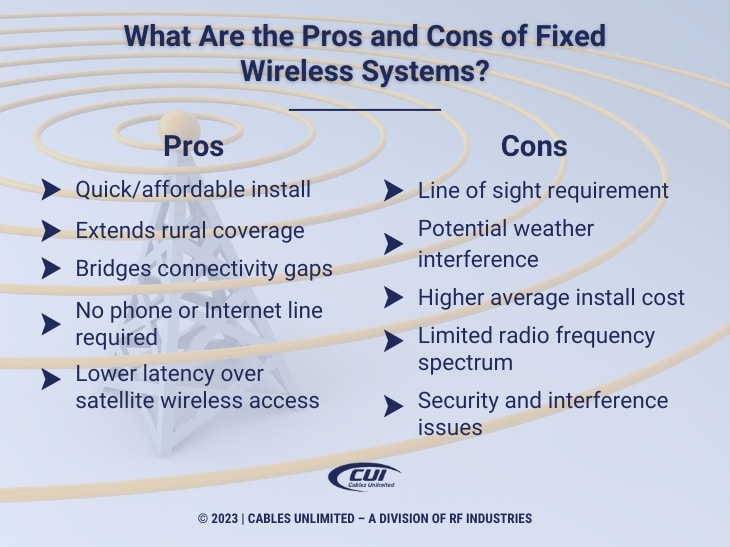
We Can Meet Your Custom Cable Assembly and Wire Harness Needs
Fixed wireless access in the home or office requires custom data cables, custom wire harnesses, and custom cable assemblies to meet the needs of each unique installation. This is even more true regarding the supporting infrastructure at the tower. Just as fiber optic and custom cables are used in network centers, they are used throughout the fixed wireless access system.
We have a well-developed process for manufacturing custom data cables, wire harnesses, and cable assemblies. We also have significant experience meeting each application’s and every customer’s needs.
If your requirements are already specified and ready for a quote for your current projects, we are prepared to meet your deadlines and pricing targets. Our extensive in-house services and advanced manufacturing capabilities are in place to meet your requirements.
But Cables-Unlimited offers much more than state-of-the-art manufacturing – our dedicated team is also known for going to great lengths to meet the needs of our customers, including working round-the-clock to meet tight turnaround time requirements.
Our sales representatives are standing by to assist you with product questions and quotes Monday – Friday, 8:00 am to 5:00 pm Eastern. Of course, you can also email us or complete our contact form, and we’ll get right back to you.

